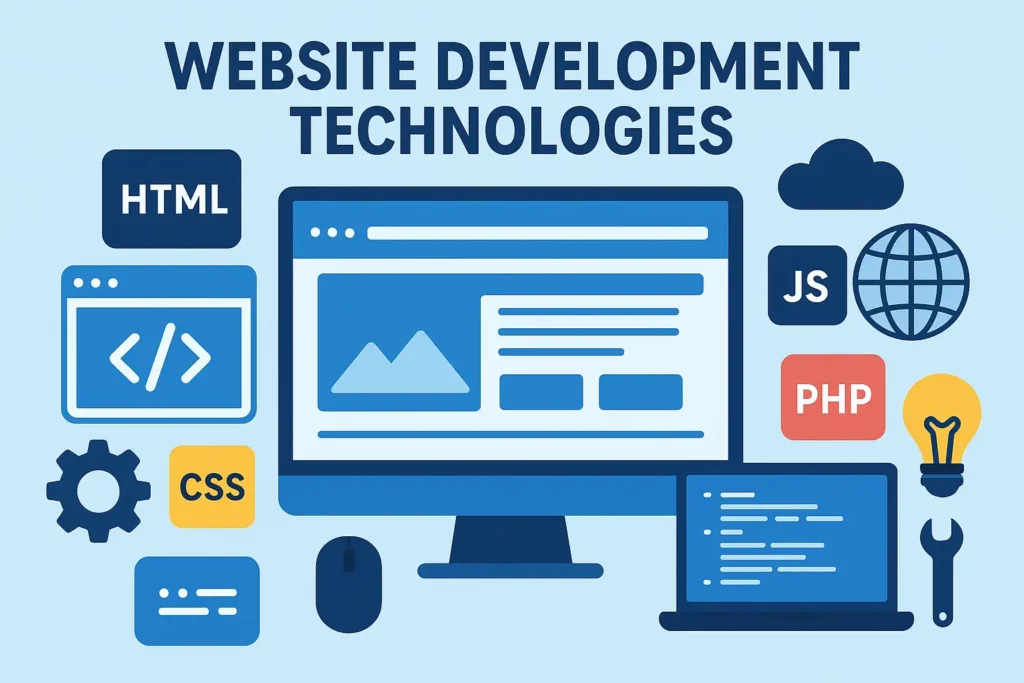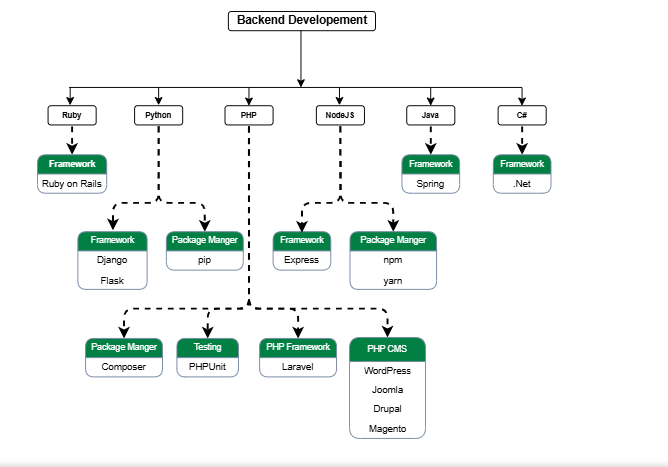8 Popular Website Development Technologies 2025

Building websites and applications is easier today with modern tools. Whether you’re new or experienced, knowing the right technologies is key. In this article, we’ll explore 8 essential web development technologies, from basics like HTML and CSS to advanced frameworks and databases. Some shape user interfaces, while others manage backend data and operations. Together, they provide the foundation to build everything from simple websites to complex apps. In this article, you will get to know about the popular website development technologies.
Top 8 Website Development Technologies

1. HTML: The Foundation of Every Website
Let’s start with the basics. HTML (HyperText Markup Language) is literally what gives a website structure. It’s like the bones of a webpage. Want a headline? A button? A paragraph? HTML tells your browser, “Hey, this is what goes where.”
Why it matters:
- Every website needs it – period.
- It’s simple and beginner-friendly.
- It works hand-in-hand with other tools like CSS and JavaScript.
Also Read , How to Build Your Startup in 2025
2. CSS: Where Style Meets Structure
Okay, so you’ve got a frame – now it needs some flair. That’s where CSS (Cascading Style Sheets) comes in. CSS handles the colors, fonts, spacing, layout, and even animations. It makes things look good.
Why it matters:
- Makes your site visually appealing.
- Helps with responsive design (hello, mobile-friendliness!).
- Keeps style separate from content – cleaner and easier to manage.
3. JavaScript : After Style Interactivity
Now that your site looks nice, it needs to do something. That’s what JavaScript is for. It adds interactivity – like forms that validate input, buttons that do stuff when clicked, and content that updates without refreshing the page.
Why it matters:
- Essential for modern, interactive websites.
- Runs directly in your browser—no server needed.
- Powers tons of tools, plugins, and libraries.
4. React.js: JavaScript, Supercharged
Ever notice how modern apps like Instagram or Airbnb feel lightning fast? That’s often thanks to React, a powerful JavaScript library built by Facebook.
React breaks your website into small, reusable components. So instead of building one big, messy site, you build lots of little blocks that work together. Smart, right?
Why it matters:
- Great for building fast, dynamic user interfaces.
- Saves time through reusable code.
- Used by some of the biggest names on the web.
Also Read, 10 Web Development Services
5. Node.js: JavaScript on the Server Side
Traditionally, JavaScript was just for the front end (what users see). But with Node.js, you can use JavaScript to power the back end too – the behind-the-scenes part that handles things like user data, logins, and server logic.
Why it matters:
- Lets you use one language (JavaScript) for everything.
- Fast, efficient, and scalable.
- Great for real-time apps like chats or live dashboards.
6. Python + Django: Clean, Powerful, and Friendly
Python is known for being super readable and beginner-friendly. Pair it with Django, a web framework that helps you build websites quickly and securely, and you’ve got a powerhouse combo.
Python + Django is often used for apps that need speed, security, and simplicity – like marketplaces, content platforms, or dashboards.
Why it matters:
- Easy to learn and clean to write.
- Django handles a lot of the heavy lifting for you.
- Trusted by big names like Instagram and Pinterest.
7. PHP + Laravel: Old School, But Still Rocking
You’ve probably heard mixed things about PHP. Yes, it’s been around forever — but it’s still the engine behind platforms like WordPress, which powers more than 40% of the web.
Laravel, a modern PHP framework, gives PHP a fresh spin. It’s elegant, fast, and packed with tools that make backend development a breeze.
Why it matters:
- Perfect for websites with lots of content or custom features.
- Laravel makes PHP development clean and efficient.
- Great for blogs, forums, business sites, and more.
8. SQL & NoSQL Databases: Storing Your Stuff
Your website needs somewhere to store its data like users, posts, products, or messages. That’s where databases come in.
- SQL (Structured Query Language) databases like MySQL or PostgreSQL are perfect for organized, structured data.
- NoSQL databases like MongoDB are more flexible – great for apps that need to scale quickly or handle messy data.
Why it matters:
- Without a database, your site can’t save or retrieve info.
- The right database choice depends on your needs.
Most modern sites use both types in different ways.
If you are confusion how to choose lifetime cloud Storage you can check this!
Main Types of Website Development Technology
Now that we’ve covered the top 8 tools, let’s group them by category to give you a better picture of how they all fit together:

Frontend Technologies (what users see)
- HTML
- CSS
- JavaScript
- React.js (or other JS frameworks)
Backend Technologies (what Search Engine see)
- Node.js
- Python + Django
- PHP + Laravel

Database Technologies (where your data lives)
- SQL (MySQL, PostgreSQL)
- NoSQL (MongoDB, Firebase)
Each layer plays a role. Together, they create a full-stack web application one that looks good, runs fast, and stores information securely.
Which Technology Should You Use?
Honestly, it depends. There’s no “one-size-fits-all” solution when it comes to technology for website development. It ultimately comes down to a few key questions.
- What kind of website are you building? (Simple blog? E-commerce site? Web app?)
- How complex will it get over time?
- Who’s building it – you or a development team?
- Do you care more about speed, security, scalability – or all of the above?
If you’re working with developers, ask them to explain their stack and why it’s a good fit. If you’re learning this stuff yourself, start with HTML, CSS, and JavaScript – then branch out.
Conclusion
Website development technology has come a long way from the days of simple HTML pages. Today’s web is fast, interactive, and powered by some seriously impressive technology.
But here’s the thing: You don’t need to know everything to make great decisions. Just understanding the basics of the types of website development technology puts you ahead of the curve.
Whether you’re launching a new startup, redesigning an old site, or just exploring your options, the tools we talked about above are the building blocks of the modern internet. At WebWorks Co., we use these technologies to help businesses create modern, scalable, and user-friendly websites that drive real growth.
